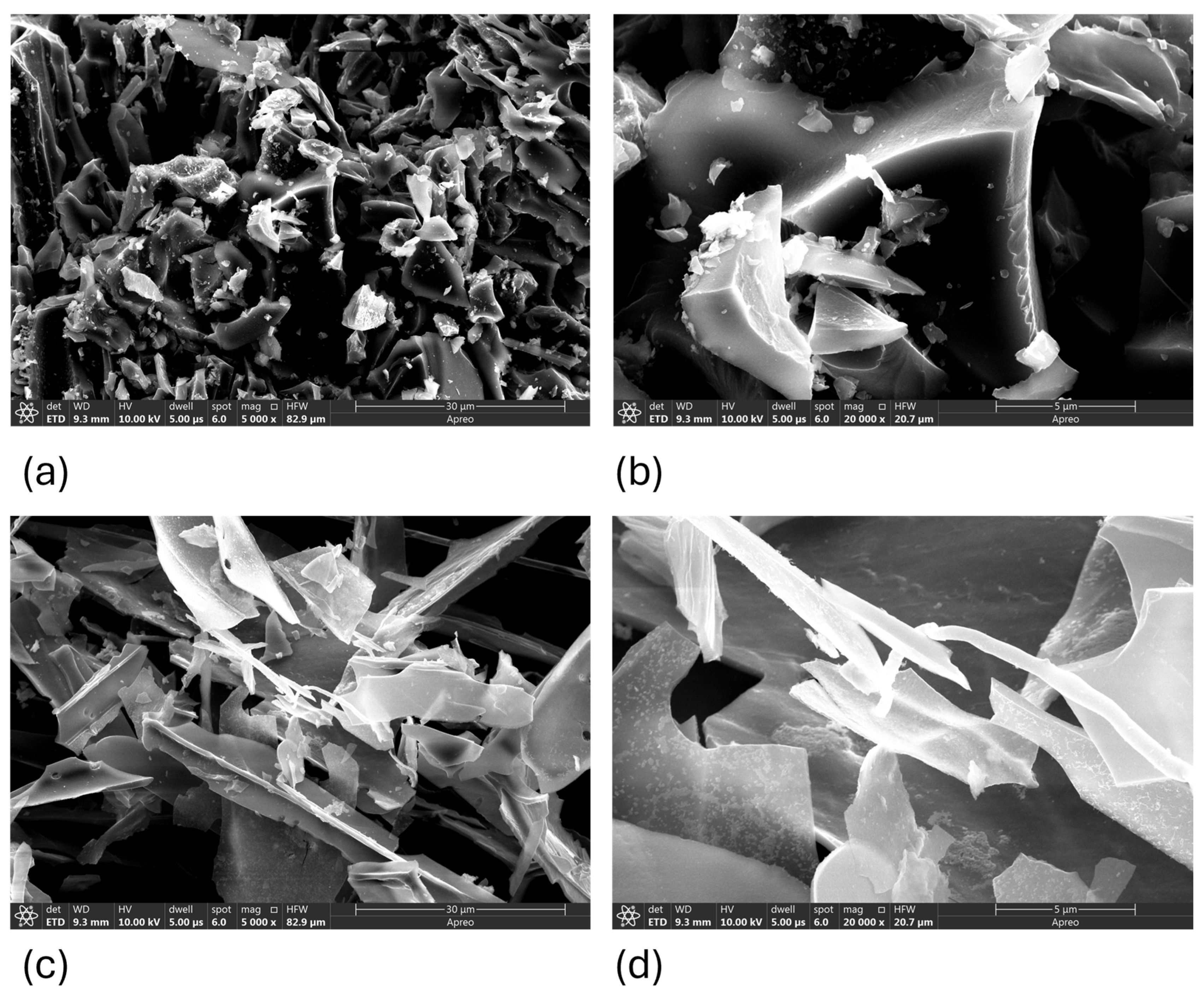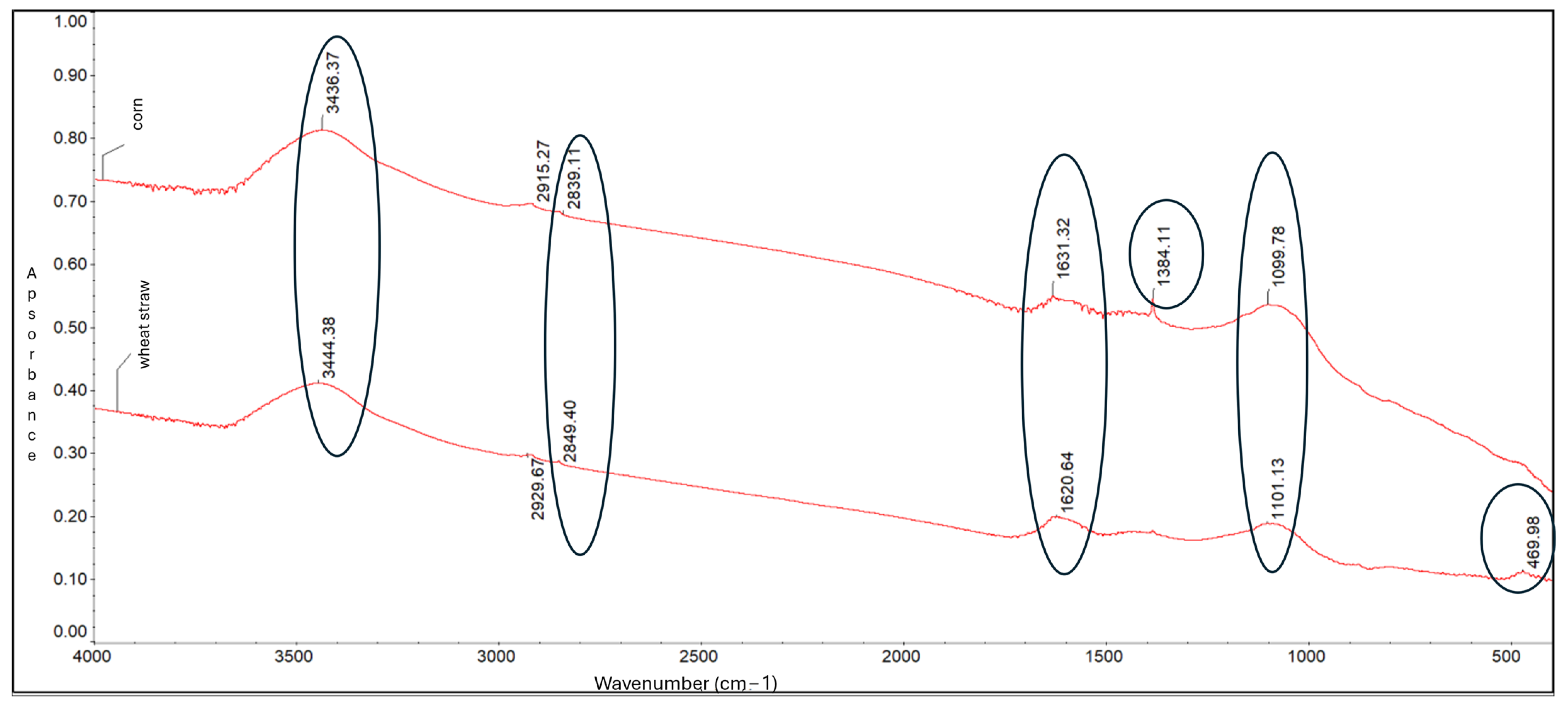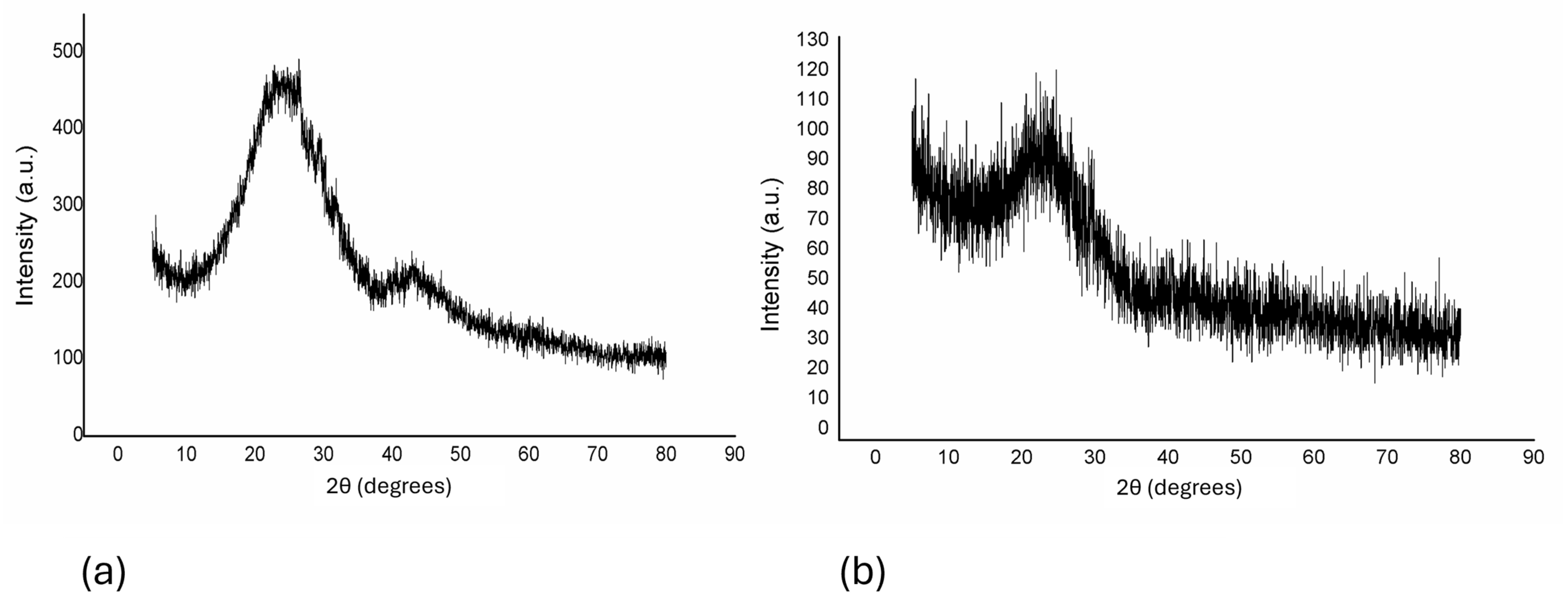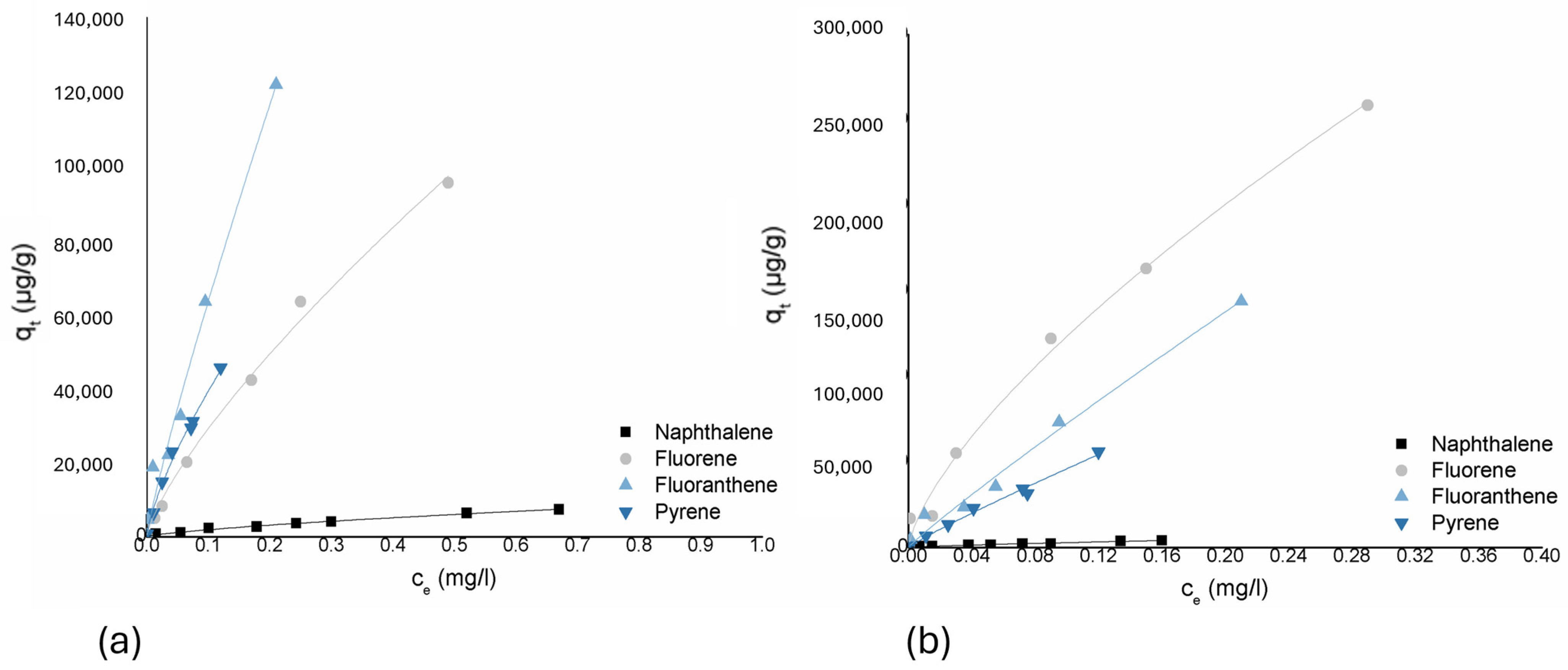Adsorptive Behavior of Corn-Cob- and Straw-Derived Biochar for Polycyclic Aromatic Hydrocarbon Removal from Aqueous Systems
Abstract
1. Introduction
2. Materials and Methods
2.1. Feedstock and Biochar Preparation
2.2. Biochar Characterization
- FTIR Analysis. Functional groups present on the biochar surface were identified through Fourier-transform infrared spectroscopy (FTIR) using a “Nicolet Nexus 670” (Thermo Fisher Scientific, Waltham, MA, USA). Samples were prepared by forming KBr-based tablets, and spectra were recorded within the 4000–400 cm−1 range using the diffuse reflection mode at a resolution of 4 cm−1.
- pXRD Analysis. The crystalline structure of the biochar was examined using a Rigaku Miniflex 2 X-ray diffractometer equipped with a Cu Kα radiation source. The pXRD patterns were recorded with a 4°/min resolution, covering a 2θ range of 4–80° (2θ = 10–80°).
- SEM and EDS Analysis. The surface morphology of the biochar samples was analyzed using a Thermo Fisher Scientific Apreo C scanning electron microscope (Waltham, MA, USA). Elemental composition was determined via the integrated energy-dispersive X-ray spectroscopy (EDS) system. The scanning electron microscope was operated at a 40 nA current and 20 kV acceleration voltage for optimal imaging and analysis.
2.3. Chemicals and Methods of Analysis
2.4. Adsorption Experiment Setup
3. Results
3.1. Biochar Characterization
3.2. Adsorption Performance
4. Discussion
| Paper Scope and Conclusions | Used Material/Obtained Results | Reference |
|---|---|---|
| Impact of biochar on sorption of PAHs in water. The application of biochar led to a decrease in the concentration of the examined PAHs in water. Enhancing the contact duration and increasing the amount of biochar enhances the efficiency of PAH elimination. | 100 mg/L biochar reduced benzo(a)pyrene by 78%. Benzo(g,h,i)perylene and indeno(1,2,3-cd)pyrene decreased by 81%. | [56] |
| Adsorption of PAH from aqueous solutions on different sorbents. The highest efficiency of PAH removal (98.1%) was observed for activated carbon. The sorption processes can be used in aqueous-solution treatment procedures. | Sum of PAH removal: quartz sand bed (75.5%) mineral sorbent bed (58.2%) activated-carbon bed (98.1%) quartz sand/mineral sorbent bed (45.4%) quartz sand/activated-carbon bed (79.4%) quartz sand/mineral sorbent/ activated-carbon bed (69.7%) | [54] |
| Using natural adsorbents to reduce polycyclic aromatic hydrocarbons contamination of oily wastewater. The adsorption process in all investigated systems was favorable, and rice bran and sawdust are suitable alternatives in comparison with activated carbon, economically. | Activated carbon and rice bran had the highest adsorption of PAHs (92.1% and 91.5% respectively) within 60 min. Sawdust had a slightly lower adsorption of PAHs (88.5%) after 30 min. | [59] |
| The activated-carbon adsorption of PAHs. It focuses specifically on the effectiveness of activated-carbon adsorption, particularly wheat straw pyrolyzed under specific conditions, achieving 98.6% removal of fluoranthene. | The best method for PAH removal is AC adsorption using wheat straw pyrolyzed with limiting oxygen conditions at 800 °C for 6 h with 2 g/L dosages. This method achieved a 98.6% removal efficiency of fluoranthene. | [61] |
| Removal of naphthalene from produced water using oil-palm-leaf-waste activated carbon. | 92.48% removal efficiency of naphthalene in aquatic solution. 70.5% removal efficiency from produced water sample. | [62] |
| Valorizing biochar from Dunaliella salina biomass for naphthalene removal from aqueous rural environment. | Dunaliella salina biochar achieved removal efficiencies between 27% and 63%, depending on the naphthalene concentrations, which ranged from 25 to 150 mg/L. | [63] |
5. Conclusions
Author Contributions
Funding
Data Availability Statement
Acknowledgments
Conflicts of Interest
References
- Mishra, R.K.; Mentha, S.S.; Misra, Y.; Dwivedi, N. Emerging pollutants of severe environmental concern in water and wastewater: A comprehensive review on current developments and future research. Water-Energy Nexus 2023, 6, 74–95. [Google Scholar] [CrossRef]
- Montano, L.; Baldini, G.M.; Piscopo, M.; Liguori, G.; Lombardi, R.; Ricciardi, M.; Esposito, G.; Pinto, G.; Fontanarosa, C.; Spinelli, M.; et al. Polycyclic Aromatic Hydrocarbons (PAHs) in the Environment: Occupational Exposure, Health Risks and Fertility Implications. Toxics 2025, 13, 151. [Google Scholar] [CrossRef]
- Venkatraman, G.; Giribabu, N.; Mohan, P.S.; Muttiah, B.; Govindarajan, V.K.; Alagiri, M.; Abdul Rahman, P.S.; Karsani, S.A. Environmental impact and human health effects of polycyclic aromatic hydrocarbons and remedial strategies: A detailed review. Chemosphere 2024, 351, 141227. [Google Scholar] [CrossRef] [PubMed]
- Maletić, S.P.; Beljin, J.M.; Rončević, S.D.; Grgić, M.G.; Dalmacija, B.D. State of the art and future challenges for polycyclic aromatic hydrocarbons is sediments: Sources, fate, bioavailability and remediation techniques. J. Hazard. Mater. 2019, 365, 467–482. [Google Scholar] [CrossRef]
- Beljin, J.; Đukanović, N.; Anojčić, J.; Simetić, T.; Apostolović, T.; Mutić, S.; Maletić, S. Biochar in the Remediation of Organic Pollutants in Water: A Review of Polycyclic Aromatic Hydrocarbon and Pesticide Removal. Nanomaterials 2025, 15, 26. [Google Scholar] [CrossRef]
- Yaashikaa, P.R.; Kumar, P.S.; Varjani, S.; Saravanan, A. A critical review on the biochar production techniques, characterization, stability and applications for circular bioeconomy. Biotechnol. Rep. 2020, 28, e00570. [Google Scholar] [CrossRef]
- Olugbenga, O.S.; Adeleye, P.G.; Oladipupo, S.B.; Adeleye, A.T.; John, K.I. Biomass-derived biochar in wastewater treatment- a circular economy approach. Waste Manag. Bull. 2023, 1, 1–14. [Google Scholar] [CrossRef]
- Yan, S.; Yu, W.; Yang, T.; Li, Q.; Guo, J. The Adsorption of Corn Stalk Biochar for Pb and Cd: Preparation, Characterization, and Batch Adsorption Study. Separations 2022, 9, 22. [Google Scholar] [CrossRef]
- Majumder, S.; Sharma, P.; Singh, S.P.; Nadda, A.K.; Sahoo, P.K.; Xia, C.; Sharma, S.; Ganguly, R.; Lam, S.S.; Kim, K.H. Engineered biochar for the effective sorption and remediation of emerging pollutants in the environment. J. Environ. Chem. Eng. 2023, 11, 109590. [Google Scholar] [CrossRef]
- Zhou, Y.; Wei, Z.; Yao, S.; Li, Z.; Zhang, Z.; Ji, L.; Jing, H. Activated biochar derived from Enteromorpha with high specific surface area for efficient removal of phenanthrene: Experiments, mechanism and DFT calculations. Environ. Pollut. 2024, 340 Pt 2, 122709. [Google Scholar] [CrossRef]
- Qu, J.; Meng, Q.; Peng, W.; Shi, J.; Dong, Z.; Li, Z.; Hu, Q.; Zhang, Q.; Wang, L.; Ma, S.; et al. Application of functionalized biochar for adsorption of organic pollutants from environmental media: Synthesis strategies, removal mechanisms and outlook. J. Clean. Prod. 2023, 423, 138690. [Google Scholar] [CrossRef]
- Wang, C.; Lin, X.; Zhang, X.; Show, P.L. Research advances on production and application of algal biochar in environmental remediation. Environ. Pollut. 2024, 348, 123860. [Google Scholar] [CrossRef] [PubMed]
- Fabian, P.S.; Lee, D.H.; Shin, S.W.; Kang, J.H. Assessment of pyrene adsorption on biochars prepared from green infrastructure plants: Toward a closed-loop recycling in managing toxic stormwater pollutants. J. Water Process Eng. 2022, 48, 102929. [Google Scholar] [CrossRef]
- Murtaza, G.; Ahmed, Z.; Valipour, M.; Ali, I.; Usman, M.; Iqbal, R.; Zulfiqar, U.; Rizwan, M.; Mahmood, S.; Ullah, A.; et al. Recent trends and economic significance of modified/functionalized biochars for remediation of environmental pollutants. Sci. Rep. 2024, 14, 217. [Google Scholar] [CrossRef]
- Chen, H.; Gao, Y.; Li, J.; Fang, Z.; Bolan, N.; Bhatnagar, A.; Gao, B.; Hou, D.; Wang, S.; Song, H.; et al. Engineered biochar for environmental decontamination in aquatic and soil systems: A review. Carbon Res. 2022, 1, 4. [Google Scholar] [CrossRef]
- Xin, Z.; Tong, J.; Wang, J.; Ruan, C.; Lyu, J.; Shi, J. Research progress on activated persulfate by biochar: Soil and water environment remediation, mechanism exploration and simulation calculation. Chem. Eng. J. 2024, 493, 152718. [Google Scholar] [CrossRef]
- Ke, Y.; Zhang, X.; Ren, Y.; Zhu, X.; Si, S.; Kou, B.; Zhang, Z.; Wang, J.; Shen, B. Remediation of polycyclic aromatic hydrocarbons polluted soil by biochar loaded humic acid activating persulfate: Performance, process and mechanisms. Bioresour. Technol. 2024, 399, 130633. [Google Scholar] [CrossRef]
- Alhothali, A.; Haneef, T.; Mustafa, M.R.U.; Moria, K.M.; Rashid, U.; Rasool, K.; Bamasag, O.O. Optimization of Micro-Pollutants’ Removal from Wastewater Using Agricultural Waste-Derived Sustainable Adsorbent. Int. J. Environ. Res. Public Health 2021, 18, 11506. [Google Scholar] [CrossRef]
- Jagadeesh, N.; Sundaram, B. Adsorption of Pollutants from Wastewater by Biochar: A Review. J. Hazard. Mater. Adv. 2023, 9, 100226. [Google Scholar] [CrossRef]
- Guo, M.; Shang, X.; Ma, Y.; Zhang, K.; Zhang, L.; Zhou, Y.; Gong, Z.; Miao, R. Biochars assisted phytoremediation of polycyclic aromatic hydrocarbons contaminated agricultural soil: Dynamic responses of functional genes and microbial community. Environ. Pollut. 2024, 345, 123476. [Google Scholar] [CrossRef]
- Li, D.; Su, P.; Tang, M.; Zhang, G. Biochar alters the persistence of PAHs in soils by affecting soil physicochemical properties and microbial diversity: A meta-analysis. Ecotoxicol. Environ. Saf. 2023, 266, 115589. [Google Scholar] [CrossRef] [PubMed]
- Satyam, S.; Patra, S. Innovations and challenges in adsorption-based wastewater remediation: A comprehensive review. Heliyon 2024, 10, e29573. [Google Scholar] [CrossRef]
- Buss, W.; Hilber, I.; Graham, M.C.; Mašek, O. Composition of PAHs in Biochar and Implications for Biochar Production. ACS Sustain. Chem. Eng. 2022, 10, 6755–6765. [Google Scholar] [CrossRef]
- Zhou, X.; Shi, L.; Moghaddam, T.B.; Chen, M.; Wu, S.; Yuan, X. Adsorption mechanism of polycyclic aromatic hydrocarbons using wood waste-derived biochar. J. Hazard. Mater. 2022, 425, 128003. [Google Scholar] [CrossRef] [PubMed]
- Sher, S.; Waseem, M.; Leta, M.K. Review of Techniques for the Removal of Polycyclic Aromatic Hydrocarbons from Produced Water. Environments 2023, 10, 40. [Google Scholar] [CrossRef]
- Kaur, K.; Kaur, R.; Kaur, H. A systematic review of lignocellulosic biomass for remediation of environmental pollutants. Appl. Surf. Sci. Adv. 2024, 19, 100547. [Google Scholar] [CrossRef]
- Beljin, J.; Kragulj Isakovski, M.; Simetić, T.; Đukanović, N.; Molnar Jazić, J.; Maletić, S.; Vujić, M. Exploring the Adsorption Behavior of Organic UV Filter on Carbon-Based Materials as Potential Carriers of Organic Contaminants in the Aquatic Environment. Appl. Sci. 2024, 14, 9424. [Google Scholar] [CrossRef]
- Sokołowski, A.; Boguszewska-Czubara, A.; Kobyłecki, R.; Zarzycki, R.; Kończak, M.; Oleszczuk, P.; Gao, Y.; Czech, B. Increased oxygen content in biochar lowered bioavailability of polycyclic aromatic hydrocarbons-related toxicity to various organisms. Bioresour. Technol. 2024, 407, 131110. [Google Scholar] [CrossRef]
- Tomczyk, A.; Vitková, J.; Botková, N.; Siryk, O.; Kondracki, B.; Szewczuk-Karpisz, K. Ammonia hydroxide and citric acid modified wheat straw-biochars: Preparation, characterization, and environmental applications. Chemosphere 2024, 356, 141916. [Google Scholar] [CrossRef]
- Ghorbani, M.; Konvalina, P.; Neugschwandtner, R.W.; Soja, G.; Bárta, J.; Chen, W.H.; Amirahmadi, E. How do different feedstocks and pyrolysis conditions effectively change biochar modification scenarios? A critical analysis of engineered biochars under H2O2 oxidation. Energy Convers. Manag. 2024, 300, 117924. [Google Scholar] [CrossRef]
- Zhang, P.; Chang, F.; Huo, L.; Yao, Z.; Luo, J. Impacts of Biochar Pyrolysis Temperature, Particle Size, and Application Rate on Water Retention of Loess in the Semiarid Region. Water 2025, 17, 69. [Google Scholar] [CrossRef]
- Sema, A.I.; Khatri, J.; Dhar, B.B.; Kulsi, G.; Bhattacharyya, J. On The Utility of Teakwood Biochar for Iron Contaminants Removal from Water. ES Mater. Manuf. 2023, 21, 871. [Google Scholar] [CrossRef]
- Kajbaf, F.; Derikvand, E.; Babarsad, S.M.; Purmohammadi, M.H.; Kharazi, G.H. Lotus-leaf biochar modified with metal oxide nanoparticles: Synthesise, characterisation and application to the photocatalytic removal of Cr6+, Cr3+ and Co2+ ions. Int. J. Environ. Anal. Chem. 2021, 103, 5851–5867. [Google Scholar] [CrossRef]
- Ahmad, M.; Rajapaksha, A.U.; Lim, J.E.; Zhang, M.; Bolan, N.; Mohan, D.; Vithanage, M.; Lee, S.S.; Ok, Y.S. Biochar as a sorbent for contaminant management in soil and water: A review. Chemosphere 2014, 99, 19–33. [Google Scholar] [CrossRef]
- Rashad, E.; Saleh, H.N.; Eltaweil, A.S.; Saleh, M.E.; Sillanpaa, M.; Mostafa, A.R. Pinewood sawdust biochar as an effective biosorbent for PAHs removal from wastewater. Biomass Conv. Bioref. 2023, 13, 13443–13459. [Google Scholar] [CrossRef]
- Esfandiar, N.; Suri, R.; McKenzie, E.R. Simultaneous removal of multiple polycyclic aromatic hydrocarbons (PAHs) from urban stormwater using low-cost agricultural/industrial byproducts as sorbents. Chemosphere 2021, 274, 129812. [Google Scholar] [CrossRef]
- Wang, J.; Wang, S. Preparation, modification and environmental application of biochar: A review. J. Clean. Prod. 2019, 227, 1002–1022. [Google Scholar] [CrossRef]
- Lee, J.E.; Park, Y.-K. Applications of Modified Biochar-Based Materials for the Removal of Environment Pollutants: A Mini Review. Sustainability 2020, 12, 6112. [Google Scholar] [CrossRef]
- Zhang, C.; Liu, L.; Zhao, M.; Rong, H.; Xu, Y. The environmental characteristics and applications of biochar. Environ. Sci. Pollut. Res. 2018, 25, 21525–21534. [Google Scholar] [CrossRef]
- Varkolu, M.; Gundekari, S.; Omvesh; Palla, V.C.S.; Kumar, P.; Bhattacharjee, S.; Vinodkumar, T. Recent Advances in Biochar Production, Characterization, and Environmental Applications. Catalysts 2025, 15, 243. [Google Scholar] [CrossRef]
- Trivedi, Y.; Sharma, M.; Mishra, R.K.; Sharma, A.; Joshi, J.; Gupta, A.B.; Achintya, B.; Shah, K.; Vuppaladadiyamd, A.K. Biochar potential for pollutant removal during wastewater treatment: A comprehensive review of separation mechanisms, technological integration, and process analysis. Desalination 2025, 600, 118509. [Google Scholar] [CrossRef]
- Tan, X.; Liu, Y.; Zeng, G.; Wang, X.; Hu, X.; Gu, Y.; Yang, Z. Application of biochar for the removal of pollutants from aqueous solutions. Chemosphere 2015, 125, 70–85. [Google Scholar] [CrossRef]
- Tan, X.F.; Zhu, S.S.; Wang, R.P.; Chen, Y.D.; Show, P.L.; Zhang, F.F.; Ho, S.H. Role of biochar surface characteristics in the adsorption of aromatic compounds: Pore structure and functional groups. Chin. Chem. Lett. 2021, 32, 2939–2946. [Google Scholar] [CrossRef]
- Hassan, M.; Liu, Y.; Naidu, R.; Parikh, S.J.; Du, J.; Qi, F.; Willett, I.R. Influences of feedstock sources and pyrolysis temperature on the properties of biochar and functionality as adsorbents: A meta-analysis. Sci. Total Environ. 2020, 744, 140714. [Google Scholar] [CrossRef] [PubMed]
- Li, Y.; Chen, W.; Fang, S.; Xu, Z.; Weng, H.; Zhang, X. The Influence of Pyrolysis Temperature and Feedstocks on the Characteristics of Biochar-Derived Dissolved Organic Matter: A Systematic Assessment. Clean Technol. 2024, 6, 1314–1325. [Google Scholar] [CrossRef]
- Han, L.; Sun, H.; Sun, K.; Yang, Y.; Fang, L.; Xing, B. Effect of Fe and Al ions on the production of biochar from agricultural biomass: Properties, stability and adsorption efficiency of biochar. Renew. Sustain. Energy Rev. 2021, 145, 111133. [Google Scholar] [CrossRef]
- Yao, C.; Wang, B.; Hassan, M.; Xu, H.; Wang, H. Removal mechanisms of polycyclic aromatic hydrocarbons in biochar and its effects on plant growth. J. Environ. Sci. 2025. [Google Scholar] [CrossRef]
- Hale, S.E.; Alling, V.; Martinsen, V.; Mulder, J.; Breedveld, G.D.; Cornelissen, G. The sorption and desorption of phosphate-P, ammonium-N and nitrate-N in cacao shell and corn cob biochars. Chemosphere 2013, 91, 1612–1619. [Google Scholar] [CrossRef]
- Tomczyk, A.; Sokołowska, Z.; Boguta, P. Biochar physicochemical properties: Pyrolysis temperature and feedstock kind effects. Rev. Environ. Sci. Biotechnol. 2020, 19, 191–215. [Google Scholar] [CrossRef]
- Keiluweit, M.; Nico, P.S.; Johnson, M.G.; Kleber, M. Dynamic molecular structure of plant biomass-derived black carbon (biochar). Environ. Sci. Technol. 2010, 44, 1247–1253. [Google Scholar] [CrossRef]
- Maroušek, J.; Minofar, B.; Maroušková, A.; Strunecký, O.; Gavurová, B. Environmental and economic advantages of production and application of digestate biochar. Environ. Technol. Innov. 2023, 30, 103109. [Google Scholar] [CrossRef]
- Oni, B.A.; Oziegbe, O.; Olawole, O.O. Significance of biochar application to the environment and economy. Ann. Agric. Sci. 2019, 64, 222–236. [Google Scholar] [CrossRef]
- Cao, X.; Ma, L.; Gao, B.; Harris, W. Dairy-manure derived biochar effectively sorbs lead and atrazine. Environ. Sci. Technol. 2009, 43, 3285–3291. [Google Scholar] [CrossRef]
- Smol, M.; Wlodarczyk-Makula, M.; Wloka, D. Adsorption of polycyclic aromatic hydrocarbons (pahs) from aqueous solutions on different sorbents, Civil and environmental engineering reports. Civ. Environ. Eng. Rep. 2014, 13, 87–96. [Google Scholar] [CrossRef][Green Version]
- Kołtowski, M.; Hilber, I.; Bucheli, T.D.; Oleszczuk, P. Effect of activated carbon and biochars on the bioavailability of polycyclic aromatic hydrocarbons in different industrially contaminated soils. Environ. Sci. Pollut. Res. 2016, 23, 11058–11068. [Google Scholar] [CrossRef] [PubMed]
- Rosińska, A. Impact of biochar on sorption of polycyclic aromatic hydrocarbons in water. Desalination Water Treat. 2023, 305, 103–113. [Google Scholar] [CrossRef]
- Bentley, M.J.; Kennedy, A.K.; Summers, R.S. Optimizing biochar adsorption relative to activated carbon in water treatment. In Sustainable Biochar for Water and Wastewater Treatment; Mohan, D., Pittman, C.U., Mlsna, T.E., Eds.; Elsevier: Amsterdam, The Netherlands, 2022; pp. 737–773. ISBN 9780128222256. [Google Scholar] [CrossRef]
- Pathak, S.; Sakhiya, A.K.; Anand, A.; Pant, K.K.; Kaushal, P. A state-of-the-art review of various adsorption media employed for the removal of toxic Polycyclic aromatic hydrocarbons (PAHs): An approach towards a cleaner environment. J. Water Process Eng. 2022, 47, 102674. [Google Scholar] [CrossRef]
- Farahani, M.; Behbahaninia, A. Using natural adsorbents to reduce polycyclic aromatic hydrocarbons contamination of oily wastewater. J. Biodivers. Environ. Sci. (JBES) 2014, 5, 274–281. [Google Scholar]
- Tsyntsarski, B.; Petrova, B.; Budinova, T.; Petrov, N.; Velasco, L.; Ania, C.O. Characterization and application of activated carbon from biomass and coal wastes for naphthalene removal. Bulg. Chem. Commun. 2011, 43, 552–557. [Google Scholar]
- Razak, N.A.A.; Hanafi, M.H.M.; Razak, N.H.; Ibrahim, A.; Omar, A.A. The Activated Carbon Adsorption of Polycyclic Aromatic Hydrocarbons: The Best Evidence Review. In Proceedings of the 7th International Conference and Exhibition on Sustainable Energy and Advanced Materials (ICE-SEAM 2021), Melaka, Malaysia; Abdollah, M.F.B., Amiruddin, H., Phuman Singh, A.S., Abdul Munir, F., Ibrahim, A., Eds.; Springer: Berlin/Heidelberg, Germany, 2021. [Google Scholar] [CrossRef]
- Ul Mustafa, M.R.; Khurshid, H.; Ho, Y.C.; Isa, M.H. Removal of Naphthalene from Produced Water Using Oil Palm Leaves Waste Activated Carbon. In Proceedings of the International Conference on Emerging Smart Cities (ICESC2022); Mohammed, B.S., Min, T.H., Sutanto, M.H., Joewono, T.B., As’ad, S., Eds.; Springer Nature: Singapore, 2022. [Google Scholar] [CrossRef]
- Nama, M.; Satasiya, G.; Sahoo, T.P.; Moradeeya, P.G.; Sadukha, S.; Singhal, K.; Saravaia, H.T.; Dineshkumar, R.; Anil Kumar, M. Thermo-chemical behaviour of Dunaliella salina biomass and valorising their biochar for naphthalene removal from aqueous rural environment. Chemosphere 2024, 353, 141639. [Google Scholar] [CrossRef]




| Research Gap | Key Insights | Citation |
|---|---|---|
| Lack of Field-Scale Studies | Most studies are lab-based; field-scale applications are underexplored. | [5,9] |
| Adsorption Mechanisms in Complex Matrices | Need to understand π-π conjugation and hydrogen bonding in real-world conditions. | [10,11] |
| Long-Term Stability and Impact | Potential leaching and ecological effects require further study. | [12,13] |
| Standardization of Production | Variability in biochar properties due to production conditions. | [9,14] |
| Economic and Scalability Assessments | High production costs and logistical challenges need addressing. | [5,9] |
| Biochar Modifications | Stability and environmental impact of modified biochars need investigation. | [14,15] |
| Combined Remediation Strategies | Synergistic effects with other technologies require further exploration. | [16,17] |
| Environmental Factor Impact | Predictive models needed for diverse conditions. | [16,18] |
| Microbial Degradation Role | Biochar’s role in aquatic microbial degradation is underexplored. | [19,20] |
| Reuse and Regeneration | Long-term efficiency after multiple cycles needs assessment. | [20,21] |
| Parameters | Corn | Wheat Straw |
|---|---|---|
| pH | 9.16 ± 0.02 | 8.94 ± 0.13 |
| Ash (% w/w) | 3.03 ± 0.14 | 6.4 ± 1.25 |
| Moisture (% w/w) | 2.51 ± 0.21 | 2.09 ± 0.31 |
| Volatile matter (% w/w) | 38.2 ± 5.02 | 52.4 ± 4.25 |
| Sample | C | H | O | Si | P | S | Ca | Mn | Cu |
|---|---|---|---|---|---|---|---|---|---|
| wt % | |||||||||
| Wheat straw | 69 | 5.8 | 14.2 | 0.8 | 1.8 | 1.2 | 6.7 | 0.2 | 0.3 |
| Corn cob | 63 | 7.1 | 13.2 | 11.1 | 0.9 | 0.4 | 3.3 | 0.7 | 0.3 |
| Adsorbents | Parameter | ||||||||
|---|---|---|---|---|---|---|---|---|---|
| BET (m2/g) | Micropore HK Method (cm3/g) | Mesopore (cm3/g) | Pore Radius (Å) | Pore Volume (cm3/g) | Elemental Analysis | ||||
| C (%) | H (%) | N (%) | S (%) | ||||||
| Biochar corn | 111 | 0.003 | 0.014 | 27.5 | 0.028 | 70.7 | 0.210 | 1.12 | 1.39 |
| Biochar straw | 61 | 0.001 | 0.011 | 28.5 | 0.022 | 67.8 | 0.281 | 1.05 | 2.21 |
| Corn Biochar | Straw Biochar | |||||
|---|---|---|---|---|---|---|
| KF (mg/g)/(mg/L)n | n | Log Kd (0.05 mg/L) | KF (mg/g)/(mg/L)n | n | LogKd (0.05 mg/L) | |
| Naphthalene | 10,163 | 0.732 | 4.35 | 18,444 | 0.819 | 4.61 |
| Fluorene | 188,620 | 0.839 | 5.48 | 77,296 | 0.789 | 5.15 |
| Fluoranthene | 552,874 | 0.897 | 5.87 | 660,116 | 0.923 | 5.83 |
| Pyrene | 254,947 | 0.798 | 5.66 | 293,398 | 0.823 | 5.69 |
Disclaimer/Publisher’s Note: The statements, opinions and data contained in all publications are solely those of the individual author(s) and contributor(s) and not of MDPI and/or the editor(s). MDPI and/or the editor(s) disclaim responsibility for any injury to people or property resulting from any ideas, methods, instructions or products referred to in the content. |
© 2025 by the authors. Licensee MDPI, Basel, Switzerland. This article is an open access article distributed under the terms and conditions of the Creative Commons Attribution (CC BY) license (https://creativecommons.org/licenses/by/4.0/).
Share and Cite
Beljin, J.; Isakovski, M.K.; Agbaba, J.; Vujić, M.; Maletić, S.; Tubić, A. Adsorptive Behavior of Corn-Cob- and Straw-Derived Biochar for Polycyclic Aromatic Hydrocarbon Removal from Aqueous Systems. Processes 2025, 13, 1521. https://doi.org/10.3390/pr13051521
Beljin J, Isakovski MK, Agbaba J, Vujić M, Maletić S, Tubić A. Adsorptive Behavior of Corn-Cob- and Straw-Derived Biochar for Polycyclic Aromatic Hydrocarbon Removal from Aqueous Systems. Processes. 2025; 13(5):1521. https://doi.org/10.3390/pr13051521
Chicago/Turabian StyleBeljin, Jelena, Marijana Kragulj Isakovski, Jasmina Agbaba, Maja Vujić, Snežana Maletić, and Aleksandra Tubić. 2025. "Adsorptive Behavior of Corn-Cob- and Straw-Derived Biochar for Polycyclic Aromatic Hydrocarbon Removal from Aqueous Systems" Processes 13, no. 5: 1521. https://doi.org/10.3390/pr13051521
APA StyleBeljin, J., Isakovski, M. K., Agbaba, J., Vujić, M., Maletić, S., & Tubić, A. (2025). Adsorptive Behavior of Corn-Cob- and Straw-Derived Biochar for Polycyclic Aromatic Hydrocarbon Removal from Aqueous Systems. Processes, 13(5), 1521. https://doi.org/10.3390/pr13051521









